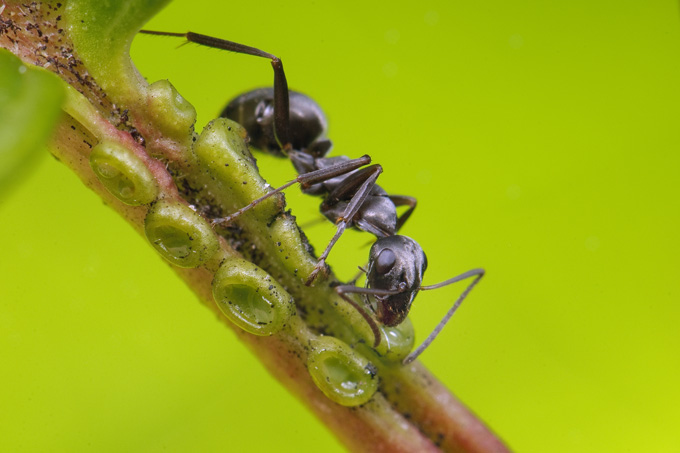Marjorie Weber explores plant-protecting ants and other wonders of evolution
Cooperation between species is an understudied driver of biodiversity

Evolutionary ecologist Marjorie Weber is fascinated by the richness of life on Earth.
M. Weber
A crack team of arthropod bodyguards may be defending that cherry tree in your backyard or the maple across the street.
Mites protect plants by acting like herds of grazing sheep, munching the fungi that creep across leaves. And ants patrol branches, ready to bite or sting hungry caterpillars — or even elephants. In return for the protection, plants offer food and housing.

This kind of cooperation has evolved over and over again, says Marjorie Weber, an evolutionary ecologist at the University of Michigan in Ann Arbor. Plant bodyguards are everywhere, she says, but most people don’t even notice.
Weber says she has long been drawn to “bizarre and interesting and underappreciated species.” As a kid, she liked roly-polys, earthworms, beetles and spiders. But more than individual bugs, Weber is fascinated by the richness of life on Earth. How did this vast assortment of species come to be? Start talking biodiversity, and Weber bubbles with questions: Why do we have so many different types of flowers? Why are there millions of insect species and relatively few species of sharks? Why did one branch of the tree of life flourish while another withered? “I’m just really passionate about these big biological mysteries,” she says.
Her office at the university looks how you might imagine it would for someone so captivated by the natural world. A fiddle-leaf fig towers over her desk and potted plants crowd the window. Science art adorns the walls: a hanging print of flowering plants’ evolutionary history, a blown-up image of a glimmering orchid bee and an illustration of Charles Darwin, his famous finches peeking out from his beard.
Since Darwin’s time, scientists studying what drives evolution have focused largely on antagonistic interactions between species, like finches competing for seeds and arms races between predators and prey. Cooperation’s role in evolution hasn’t always been taken seriously, “largely because it was viewed as a more feminine perspective,” Weber says.
Weber’s lab focuses on how cooperation drives evolution and biodiversity. She spends her time in the field, greenhouse and the lab, documenting interactions between plants and arthropods, as well as using computational techniques to analyze evolutionary patterns.
Weber may be best known for her work on extrafloral nectaries. These nectar-filled knuckles bulge from leaves and stems on some plants, leaking sugary snacks that entice ants to stick around and fend off attacks. Weber looked at extrafloral nectaries in modern vascular plants and then reconstructed the trait’s evolution across ancient plant species. The trait, she discovered, was a recipe for evolutionary success. Once the sweet structures evolved in a branch of the plant family tree, that branch quickly accumulated more species. That suggests that the opportunity to trade nectar for insect protection actually spurred plants to diversify.

“That’s not what people expected,” says Judith Bronstein, an evolutionary ecologist at the University of Arizona in Tucson. Scientists might assume such an adaptation would help a particular plant survive and its population to grow, but they don’t know why the number of plant species would multiply. “Somehow, possessing extrafloral nectaries leads to diversification,” she says. “And that’s a fantastic avenue for future research.”
Weber’s work stands out because she’s able to pull together scientific threads and braid them into something “completely new and completely different,” Bronstein says. “That’s how you trailblaze in our field.”
Weber is blazing trails elsewhere too. In 2018, she cofounded Project Biodiversify, a program to make biology education not only accurate and compelling, but also “as equitable and inclusive as possible,” Weber says.
Weber didn’t see herself as a scientist when she was young. As a student growing up in Grosse Pointe, Michigan, she didn’t see examples of women scientists, and she never thought about science as a career option. A biology course with spider scientist Greta Binford at Lewis & Clark College in Portland, Ore., changed everything. “Knowing that was a job and watching her do it was just incredibly life-shaping for me,” Weber says. Binford let Weber come work in her lab, studying brown recluse spiders. She encouraged Weber’s interests and “went out of her way to convince me that I was smart enough and could do this,” she says.
Years later, after Weber had a lab of her own, she and colleagues decided to investigate how well college biology textbooks represented a diverse set of scientists. The results, reported in 2020, called out the stark demographic mismatch between scientists featured in textbooks (mostly white men) and the students using them. Weber’s team works to bridge that gap by developing resources for teachers that highlight a diverse group of role models in biology.
Weber hopes to inspire students to learn about how the world works. She’s a “fantastic adviser,” says ecologist Eric LoPresti of the University of South Carolina in Columbia, a former postdoc in Weber’s lab. She builds a supportive community and makes sure that everyone feels involved, he says. It’s a culture LoPresti has tried to mimic in his own lab.
Weber’s advice for young people is to look around and take note of what sparks your excitement — maybe you’ll spot a curious-looking crew of ants marching up and down a tree. “That’s what it really means to be a scientist,” Weber says. “Pursue those feelings of awe and ask questions about the world with your eyes wide open.”
Marjorie Weber is one of this year’s SN 10: Scientists to Watch, our list of 10 early and mid-career scientists who are making extraordinary contributions to their field. We’ll be rolling out the full list throughout 2023.
Want to nominate someone for the SN 10? Send their name, affiliation and a few sentences about them and their work to sn10@sciencenews.org.






